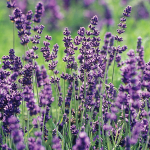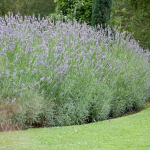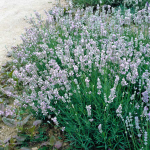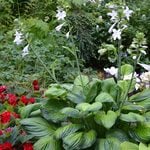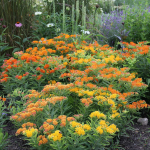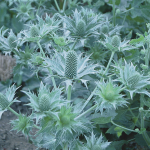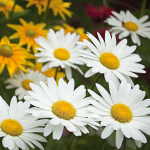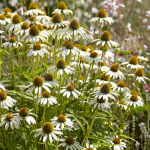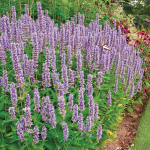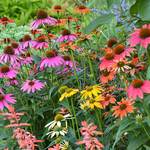Product Details
We tested half a dozen pinks before settling on Lavandula angustifolia 'Rosea,' an excellent strain of Lavender whose soft pink flowers are borne on stems seldom taller than 15″. The delicate hue seems to work a special magic with the muted foliage, adding warmth to a plant we generally think of as "cool."
Many gardeners grow Lavender for its fragrance, but the genus includes several excellent garden plants that should be more widely used for their midsummer beauty and resistance to heat and drought. The cool, gray-green foliage provides a perfect backdrop for the slender, arching flower stems. Some varieties are small, others tall, but they all prefer well-drained, sweet soil and full sun. Plant them in masses or form them into small hedges, and you'll find that they are attractive and useful long after the spent flowers have been clipped off.
Lavenders thrive in the arid West but are best treated as annuals or grown in fast-draining containers in the South.
For more information on growing Lavender, click Growing Guide.
Shipping
HOW PLANTS ARE SHIPPED
The size of the plants we ship has been selected to reduce the shock of transplanting. For some, this means a large, bareroot crown. Others cannot travel bareroot or transplant best if grown in containers. We ship these perennials and annuals in 1 pint pots, except as noted. We must point out that many perennials will not bloom the first year after planting, but will the following year, amply rewarding your patience. We ship bulbs as dormant, bare bulbs, sometimes with some wood shavings or moss. Shrubs, Roses, vines, and other woody plants may be shipped bareroot or in pots. The size of the pot is noted in the quick facts for each item.
WHEN WE SHIP
We ship our bulbs and plants at the right time for planting in your area, except as noted, with orders dispatched on a first-come, first-served basis by climate zone. We also ship a wide range of containers and planters, tools, supplies, fertilizers, garden wear, garden decor items, as well as indoor decorations like wreaths and dried bouquets when available. Estimated dates for shipping are indicated in the green Shipping Details box for each item. Please supply a street address for delivery. Kindly contact us with two weeks notice, if you'll be away at the expected time of delivery.
OUR GUARANTEE
We guarantee to ship plants that are in prime condition for growing. If your order is damaged or fails to meet your expectations, we will cheerfully replace or refund it. Please contact our Customer Service Department at 1-800-503-9624 or email us at [email protected]. Please include your order number or customer number when contacting us.
Reviews
Average Customer Rating:
 (4 Reviews)
Write a Review
(4 Reviews)
Write a Review
Sort by:
Great purchase 
Annie from Tiverton, RI
12 of 13 people found this review helpful. Do you? yes no Certified buyer
Blooms like mad 
Annie from Tiverton Rhode Island
14 of 14 people found this review helpful. Do you? yes no Certified buyer
Growing guide
Latin Name Pronunciation: lav-an'dew-luh
These aromatic subshrubs are popular in herb gardens as well as in the perennial border. The intensely perfumed blue-violet, mauve, pink, or white flowers are treasured for drying and making potpourri. The foliage of Lavender is a standout in the garden where its silvery or gray-green hues contrast nicely with its neighbors. Lavenders thrive in the arid West, but are best grown as annuals or container plants in the South, as they do not thrive in areas of high humidity (with the exception of Lavandula dentata and L. stoechas). Most are hardy from Zones 5 to 9; Spanish Lavender (L. stoechas) is only hardy in Zones 7 to 9.
Light/Watering:
- Lavenders demand full sun, although afternoon shade may be appreciated in the hottest climates.
- Plants are very drought resistant once established, but will flower better if not allowed to dry out.
Fertilizer/Soil and pH:
- Lavender thrives in soil that is not fertile
- Supplemental feeding is not necessary although plants may benefit from occasional side dressing of compost.
- Perfect drainage is a must, especially through the winter; plants will die in wet soils.
- A pH close to or slightly above neutral is best, so add lime if your soil has a pH below 7.0.
- Gravel mulch is beneficial and helps to keep the crowns of the plants away from excess moisture.
Pests/Diseases:
- Both the leaves and flowers of Lavender contain strong essential oils that are not appreciated by foraging deer or insect pests.
- In humid climates, fungal problems may arise, but can be avoided by providing excellent drainage and good air circulation around your plants.
Companions: Lavenders are lovely as an edging plant in the garden where they complement many other perennials, including Roses, Hardy Geraniums, Catmints (Calamintha), and Shasta Daisies (Leucanthemum x superba).
Pruning: Lavender is a woody subshrub, and pruning techniques should reflect this.
- Prune in spring after new growth appears
- Plants may be sheared back and shaped after flowering, but do not cut low into old wood.
- Leave plants alone for the winter.
- If older plants become unsightly, cut back by a third every three years.
Harvesting and Using Lavender: Flower spikes have the strongest scent just as the pretty little flowers begin to open.
- Cut long stems and gather in bunches to dry out of the sun – this will take four to five days in warm weather.
- Spread stems on a screen or sheet so air circulates easily.
- Use the stems of fresh or dried flower spikes in arrangements or remove the flowers for sachets and potpourri mixtures.
Reflowering: If old flower spikes are sheared off after the first bloom period, a second flush of flowers may occur later in the season.
Dividing/Transplanting:
- Younger plants handle division better than older, woody specimens.
- Plants may be moved in early spring, but keep plenty of soil around their roots when you dig them up.
Calendar of Care
Early Spring:
- Wait until new growth breaks from the woody stems before pruning.
- Remove deadwood, and shape plants.
- Divide or transplant if needed.
- Side dress plants with compost, keeping it away from the crowns of the plants.
- Check soil pH; if your soil is acidic, correct to a pH between 6.5 and 7.5.
Midspring:
- As the soil warms, mulch around plants with gravel.
Late Spring:
- Shear plants back after flowering is finished.
- Supplement natural rainfall if weather is very dry.
Summer:
- Watch for fungal problems in areas of high humidity and treat as necessary.
Fall:
- Do not cut back stems.
- In severe climates, cover plants lightly with evergreen boughs to buffer drying winter winds.
Want to learn more?
Download our ebook "Which Lavender is Right for you?"


